- August 9, 2021
- Blog, Production
- Posted by Brian Hall
- Comments Off on Top Soil Sample Depth Needs to be Consistent
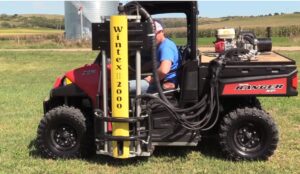 Quality soil sampling is critical to correct interpretation of results. We stress to clients this point and write often about collecting and interpreting results. This has become even more critical as agronomists and growers adopt more precision 4R nutrient management. A few years back AgVise lab completed a demonstration project on the effect of sampling depth for several nutrients. The project had 7 sampling points and 4 depth comparisons at each point. Soil Samples were collected with a Wintex 1000. Twelve cores per point were collected perpendicular to the planted rows of soybeans. The field was a well-drained sandy loam – loam texture, conventional tillage. The data indicated that phosphorus, potassium and zinc levels decreased with depth. Phosphorus & zinc move very little in soil so results were not [...]
Quality soil sampling is critical to correct interpretation of results. We stress to clients this point and write often about collecting and interpreting results. This has become even more critical as agronomists and growers adopt more precision 4R nutrient management. A few years back AgVise lab completed a demonstration project on the effect of sampling depth for several nutrients. The project had 7 sampling points and 4 depth comparisons at each point. Soil Samples were collected with a Wintex 1000. Twelve cores per point were collected perpendicular to the planted rows of soybeans. The field was a well-drained sandy loam – loam texture, conventional tillage. The data indicated that phosphorus, potassium and zinc levels decreased with depth. Phosphorus & zinc move very little in soil so results were not [...]
- April 24, 2021
- Blog, Production
- Posted by Brian Hall
- Comments Off on Soil Testing – Lots of Growth Opportunities
While I’m a big supporter of precision ag as a means to collecting data for better decision making, I was reminded recently we can’t lose sight of the fundamentals like soil testing, as boring as this may sound to growers. A 2015 Olds College survey by students highlighted the need to keep soil testing front and center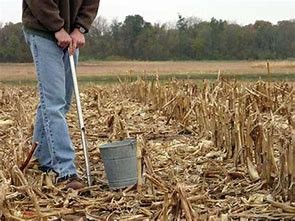 . Forty six percent of respondents only soil sample occasionally. Seventy-eight percent of farmers that use soil sampling see the information as useful, and 22% responded say they would consider zone sampling in the future.
. Forty six percent of respondents only soil sample occasionally. Seventy-eight percent of farmers that use soil sampling see the information as useful, and 22% responded say they would consider zone sampling in the future.
Why Farmers in Western Canada Use or Don’t Use Soil Sampling as Part of Their Nutrient Management Planning
- 78% of farmers had soil sampling done sometime in the past
- 22% had never used soil sampling
- 23% soil sample every 2-3 years
- 29% soil sample to [...]
- April 12, 2021
- Blog, Production
- Posted by Felix.Weber
- Comments Off on The Limits of Base Saturation in Making Nutrient Recommendations
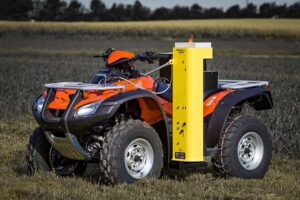 Every few years it seems base saturation rises as a winter topic as a means of making fertilizer recommendations. While base saturation has been used to determine whether a soil should be limed or not, it’s not a soil testing index, nor should be accepted broadly as an indicator for nutrient fertility. Developed for low CEC soils and highly weathered low pH soils, but not meant for many areas in Canada including Western Canada
Every few years it seems base saturation rises as a winter topic as a means of making fertilizer recommendations. While base saturation has been used to determine whether a soil should be limed or not, it’s not a soil testing index, nor should be accepted broadly as an indicator for nutrient fertility. Developed for low CEC soils and highly weathered low pH soils, but not meant for many areas in Canada including Western Canada
Read more
- February 28, 2021
- Blog, Production
- Posted by Brian Hall
- Comments Off on Managing Resistance Now
 CropLife Canada has partnered with industry, academia, and government experts to create a website, to offer resources, and promote strategies for managing disease, insect, and weed resistance. Their latest resource is Managing Herbicide-Tolerant volunteers. See this and stay abreast of the latest knowledge and resources Manage ResistanceNow
CropLife Canada has partnered with industry, academia, and government experts to create a website, to offer resources, and promote strategies for managing disease, insect, and weed resistance. Their latest resource is Managing Herbicide-Tolerant volunteers. See this and stay abreast of the latest knowledge and resources Manage ResistanceNow
- February 28, 2021
- Blog, Production
- Posted by Brian Hall
- Comments Off on
Weed herbicide resistance is one of the most serious management issues ratedfby growers, agronomists and researchers . In Eastern Canada at the top of that list is glyphosate-resistant fleabane (GR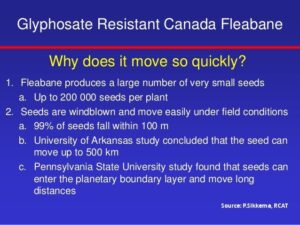 FB). First identified in southern Ontario in 2010, GRFB has spread like wildfire across Ontario and is now identified in other areas including Quebec. Fleabane seeds are small, airborne, and stick to clothing, equipment, animals. A single mature plant can produce up to 250,000 seeds/plant. Most fleabane biotypes are glyphosate-resistant, but other biotype herbicide resistance to group 2, 2 & 9, and 22 exist.Good control options exist in corn and wheat, but is problematic in soybeans.
FB). First identified in southern Ontario in 2010, GRFB has spread like wildfire across Ontario and is now identified in other areas including Quebec. Fleabane seeds are small, airborne, and stick to clothing, equipment, animals. A single mature plant can produce up to 250,000 seeds/plant. Most fleabane biotypes are glyphosate-resistant, but other biotype herbicide resistance to group 2, 2 & 9, and 22 exist.Good control options exist in corn and wheat, but is problematic in soybeans.
Article-OGF: https://b.link/GRFB_oNTFARM
Ont Diagostic Day presentation: https://b.link/Sikkama_GRFB
Research report- Dr Peter Sikkema, RCAT : https://b.link/Sikkema_GRFB
- February 28, 2021
- Blog, Production
- Posted by Brian Hall
- Comments Off on Phosphorus Balance Calculator
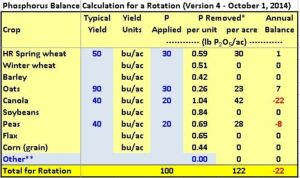 Manitoba Agriculture has developed a simple Phosphorus (P) spreadsheet calculator that allows users to input yield information and applied P during a rotation. A P balance is determined based on crop removal values, to show if soil P is being built, maintained or depleted. Phosphorus from manure applied during a rotation allows users to balance P over cropping cycle.
Manitoba Agriculture has developed a simple Phosphorus (P) spreadsheet calculator that allows users to input yield information and applied P during a rotation. A P balance is determined based on crop removal values, to show if soil P is being built, maintained or depleted. Phosphorus from manure applied during a rotation allows users to balance P over cropping cycle.
Phospohorus Balance Calculator (XLS)
- February 28, 2021
- Blog, Production
- Posted by Brian Hall
- Comments Off on Side-Banding Phosphorus a BMP for Canola
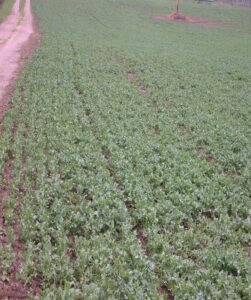 Declining soil test phosphorus in the praries has increased interest in pushing P rates higher, following a 4R approach. Where high rates of P are required, side-banding of most or all of fertilizer P should be side-banded. Seed placed P did not provide a better canola crop response even at low rates compared to side-banded. More
Declining soil test phosphorus in the praries has increased interest in pushing P rates higher, following a 4R approach. Where high rates of P are required, side-banding of most or all of fertilizer P should be side-banded. Seed placed P did not provide a better canola crop response even at low rates compared to side-banded. More
